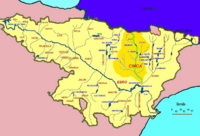Battle of Piedra Pisada facts for kids
Quick facts for kids Battle of Piedra Pisada |
|||||||||
|---|---|---|---|---|---|---|---|---|---|
| Part of the Reconquista | |||||||||
 The course of the Cinca, showing El Grado, a few miles downstream from the battle |
|||||||||
|
|||||||||
| Belligerents | |||||||||
| Christian Aragon | Muslim Zaragoza | ||||||||
| Commanders and leaders | |||||||||
| Sancho Ramírez | unknown | ||||||||
The Battle of Piedra Pisada was a fight that took place on December 25, 1084. It was fought between the Christian Kingdom of Aragon and the Muslim Taifa of Zaragoza. The battle happened on a road south of Naval in what is now Spain. This battle was a small part of the larger Reconquista. The Reconquista was a long period when Christian kingdoms slowly took back lands from Muslim rule. Sancho Ramírez, the King of Aragon, led his Christian forces in this battle.
Contents
What Was the Reconquista?
The Reconquista was a series of wars. These wars lasted for many centuries in the Iberian Peninsula. Christian kingdoms in the north fought to take back land from Muslim rulers. The land had been under Muslim control for hundreds of years. The goal was to bring these areas back under Christian rule.
Sancho Ramírez's Role
King Sancho Ramírez was a very important leader during the Reconquista. He ruled both the Kingdom of Aragon and the Kingdom of Navarre. He worked hard to expand Christian control. His efforts helped shape the future of Spain.
Where Did the Battle Happen?
The Battle of Piedra Pisada happened near a place called Piedra Pisada. This name means "stepped stone." Today, this area is known as the coto redondo de Pisa. It is a group of farms located south of the town of Naval. Naval is in the region of Aragón, Spain.
Finding the Location
Historians learned about the battle from old writings. These writings are called the Chronicle of San Juan de la Peña. One version of the chronicle says the battle was in 1083. Another version says 1084. Most experts believe 1084 is the correct year. This is because Naval was captured by Christians in 1084. It was then lost to the Muslims shortly after. This suggests the battle happened around that time.
The Fight for the Cinca Valley
The Reconquista in this area followed old Roman roads. These roads ran along rivers like the Ésera and the Cinca. Christian forces slowly moved south. They captured important towns along the way.
Key Towns and Progress
- Graus: This was a very strong Muslim city. Christians tried to capture it many times. It finally fell to the Christians in 1083.
- Naval: This town was very important for defending Barbastro. Naval was captured by Christians in 1084. But it was lost again to the Muslims soon after. It stayed under Muslim control for about ten years.
Who Won the Battle?
The old records do not clearly state who won the Battle of Piedra Pisada. However, we know that Naval was lost by the Christians shortly after the battle. This suggests that King Sancho Ramírez and his forces probably lost the fight. It seems the Muslim forces from Zaragoza were able to defeat the Aragonese army. They likely pushed them back and retook Naval.
What Happened After the Battle?
Even after this defeat, King Sancho Ramírez continued his efforts.
- Peter's Role: In 1085, Sancho made his son, Peter, king of the areas of Ribagorza and Sobrarbe. Peter was still under his father's rule.
- More Conquests: Christian forces continued to capture more land. They took Estada in 1087. They also captured Monzón in 1089.
- Naval Retaken: Naval was finally taken back by the Christians in 1095. This time, it stayed under Christian control.
See also
 In Spanish: Batalla de Piedra Pisada para niños
In Spanish: Batalla de Piedra Pisada para niños

